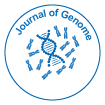Genome Research in the Light of Evolution
Received: 04-Nov-2017 / Accepted Date: 06-Nov-2017 / Published Date: 10-Nov-2017
Abstract
Already for a long time, it is clear that “Nothing in Biology Makes Sense Except in the Light of Evolution” [1]. This is more than true and crucial also for the human and generally mammalian genome that represents the highest structural and functional complexity with the most finely tuned spatial-temporal regulation, we can imagine. Hence, to understand this immense complexity of human and mammalian genome and above all the pathological conditions, it is necessary to view them in a broader, evolutionary, context. Moreover, it is necessary to view also the human genome as a result of hundreds of millions of years long evolution from our fish-like ancestors, via tetrapod amphibians and reptiles, and finally towards mammals. Therefore, to make the picture clearer and complete it is essential to explore the genomic complexity in mammalian as well as non-mammalian vertebrates. This is one of the main objectives of this newly launched journal, Journal of Genome.
Keywords: Genome, Evolutionary biology ,Epigenomics
Editorial
Already for a long time, it is clear that “Nothing in Biology Makes Sense Except in the Light of Evolution” [1]. This is more than true and crucial also for the human and generally mammalian genome that represents the highest structural and functional complexity with the most finely tuned spatial-temporal regulation, we can imagine. Hence, to understand this immense complexity of human and mammalian genome and above all the pathological conditions, it is necessary to view them in a broader, evolutionary, context. Moreover, it is necessary to view also the human genome as a result of hundreds of millions of years long evolution from our fish-like ancestors, via tetrapod amphibians and reptiles, and finally towards mammals. Therefore, to make the picture clearer and complete it is essential to explore the genomic complexity in mammalian as well as non-mammalian vertebrates. This is one of the main objectives of this newly launched journal, Journal of Genome.
Then, it is no surprise that important animal models for human diseases originate among others from fishes. This means that human diseases can be investigated with the help of even the most phylogenetically distant vertebrates as possible. One of the fundamental features of fish animal model species is that the pathological condition that they utilized for is frequently a result of specific evolutionary adaptations and as such it enables a much deeper and more complete insight into the disease etiology on the genetic and genomic level [2]. This brings us again for instance from the human medicine and pathology back to basic principles of evolutionary biology and shows the importance of such a global and interdisciplinary approach and across diverse vertebrate lineages.
At the same time, such non-mainstream animal models allow us to investigate the impact of environmental factor on the genome [3] and even more importantly, potential mechanisms how vertebrate genomes and cells react to environmental changes [4]. Although this research is still on its very beginning and mostly carried out in “simple” model organisms as e.g. yeasts with their small and well defined genomes, its next steps will lead towards vertebrates. Here again, fish model species and of course fish generally represent the initial steps of vertebrate´s genome evolution and an unprecedented genome plasticity and organizational variability, particularly when related to mammals [5]. This environmental and comparative genomics are other currently highly relevant and perspective field in the genome research, next to epigenomics and biology of transposable and other repetitive elements, with a substantial overlap towards clinical genomics and clinical research.
Finally, I would like to wish a good start with a broad repertoire of as diverse topics from across the entire genomics as possible to Journal of Genome and numerous useful and interesting contributions to all of our readers bringing them novel and exciting insights into the almost incredible world of GENOME.
References
- Dobzhansky TG (1973) Nothing in Biology Makes Sense Except in the Light of Evolution. The American Biology Teacher 35: 125-129.
- Schartl M (2014) Beyond the zebrafish: diverse fish species for modeling human disease. Dis Model Mech 7: 181-192.
- Cossins AR, CrawfordDL (2005) Fish as models for environmental genomics. Nat Rev Genet 6: 324-33.
- Jack CV, Cruz C, Hull RM, Keller MA, Ralser M, et al. (2015) Regulation of ribosomal DNA amplification by the TOR pathway. Proc Natl Acad Sci USA 112: 9674-9679.
- Venkatesh B (2003) Evolution and diversity of fish genomes. Curr Opin Genet Dev 13: 588-592.
Citation: Symonová R (2017) Genome Research in the Light of Evolution. J Genome 1:e101
Copyright: © 2017 Symonová R. This is an open-access article distributed under the terms of the Creative Commons Attribution License, which permits unrestricted use, distribution, and reproduction in any medium, provided the original author and source are credited.
Share This Article
Open Access Journals
Article Usage
- Total views: 3608
- [From(publication date): 0-2018 - Dec 06, 2023]
- Breakdown by view type
- HTML page views: 2881
- PDF downloads: 727
